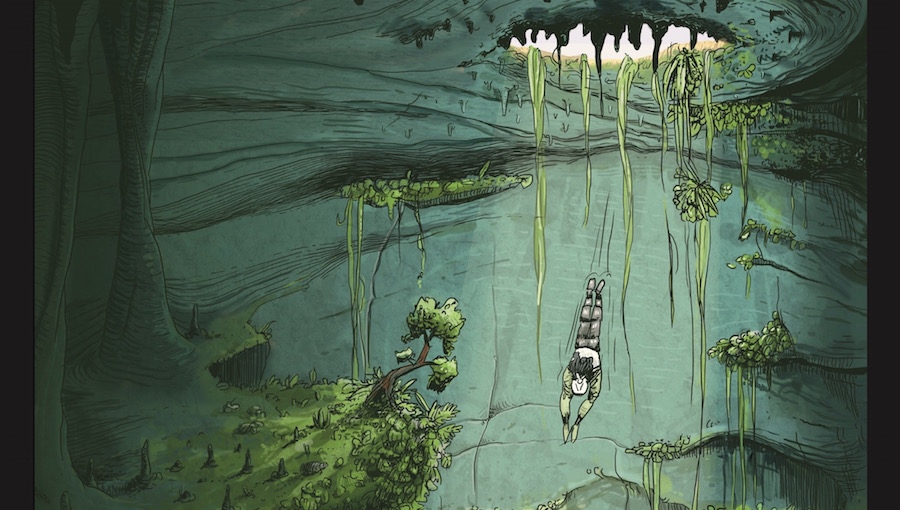The following is an interview with Emmanuel Filteau, creator of the sci-fi/fantasy comic book series, Interface. In this interview, Fanbase Press Editor-in-Chief Barbra Dillon chats with Filteau about working through his creative process in balancing the writing and artistic duties, his other upcoming projects, and more!
Barbra Dillon, Fanbase Press Editor-in-Chief: You recently released your latest sci-fi/fantasy comic book, Interface. What inspired this project, and how would you describe its premise to new readers?
Emmanuel Filteau: I think what inspired this story most was science-fiction/fantasy stories from the great masters of the ’70s. To name a few: Moebius, Druillet, Asimov, Bradbury. Here’s how I present Interface to new readers: In limitless fantasy, what is the value of a simple thing? A mysterious, green man launches himself into a quest. Within minutes, he’s attacked by an army of crabs led by none other than KING KRAB.
BD: In carrying both the writing and artistic duties of the comic, how would you describe your creative process? Do you find that one aspect is more challenging or time consuming than the other?
EF: Depending on the size/complexity of the story, I adjust my process.
- Usually, it starts as a short outline. These days, I use the note app on my phone. It’s a good practice to store as many ideas as a possible. Then, when you need an idea, you can choose the best of the lot. Often, these stories don’t work too well by themselves but may be useful in inspiring new and better ones.
- If the story is too complex to fit into a short story, I will write a proper script. It describes the action, page by page and frame by frame.
- While doing the script, I doodle in my sketchbook new characters/environments. The more I do this, the more my characters will be solid once I start working on the page. I actually built little clay miniatures for the story I’m working on now. For Interface, I saved the shell and claws of a crab as reference.
- Then, I’ll do a storyboard and adjust the script in consequence. It’s usually very rough and only I can make sense of it.
- Once done, I polish it until readable. I present it to a group of close friends for their feedback and adjust.
- Finishing. Inking. Tones. I might do a few tests to settle on a style.
- Rough-color path to insure consistency in the values and a harmonious flow.
Writing is more challenging for me. That’s why I store ideas for future reference, but drawing takes easily 80-90% more time (in my case).
BD: What do you hope that readers will take away from the comic?
EF: I hope that I can give them a short break from the crazy life we all live, but that it will also make them appreciate little things from their everyday life.
BD: Do you prefer to work exclusively in the sci-fi and fantasy genres as a creator, or do you enjoy creating in a variety of genres?
EF: If I had a great idea for a realistic story, I’d probably do it. But personally, I prefer sci-fi/fantasy.
I have a lot of respect for people who do realistic stories, but it’s another ball game. You need a lot more references/documentation for one thing. In fantasy, I have the freedom to do pretty much whatever comes to mind, and if I want a touch of realism, I’m free to make Elvis Presley ride an elephant on the rings of Saturn. (I said a touch.) There’s this new show called Super Science Friends that I find hilarious. It uses real historical figures but uses them as if they had superpowers. Check it out!
BD: Are there any other projects on which you are currently working that you are able to share with readers?
EF: Interface is a stand-alone story, but I’ve already laid out the storyboard for the sequel. I’m waiting to see how Interface does on its own to see if it’s worth continuing. Interface is actually part of a much larger one I’ve been working on the past 20 years. I’d love to it do that one, as well. The problem, as always, is time.
So, currently, I’m following Bradbury’s advice and focusing on short stories. They are much easier to wrap my head around, and I can finish them on a realistic schedule. I try not to go over 10 pages.
My latest ongoing project is called Trinket. A wanderer discovers a bazaar in the most unexpected place. There, he finds a mysterious object that enslaves his spirit. Will it consume him? I’ve just opened a Patreon to help fund my efforts here. I’m also sharing process shots on my Instagram.
BD: Are there any upcoming conventions at which fans may be able to find you and your work?
EF: I do go to conventions if I get invited or if I have something new. With my limited budget, I keep within the Montréal area. I’ve been to http://expozine.ca/en/ and http://www.fbdm-montreal.ca/en/.
When Trinket is finished, my plan is to put it in a book with Interface, another story, and unpublished illustrations. I will most likely bring this book to conventions, but I really don’t know which ones yet.
BD: Lastly, what would you like to tell fans who want to learn more about Interface?
EF: The webpage I made for the book has a few high-resolution extracts from the book to view.
Otherwise, readers can check out my Facebook page. I posted a lot of images from Interface images.
I’m always interested in answering any questions readers might have through social media. I’ll be glad to answer at my first opportunity. Twitter’s a good place for that I think.

